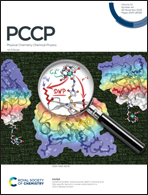A thermodynamic and kinetic study of the catalytic performance of Fe, Mo, Rh and Ru for the electrochemical nitrogen reduction reaction†
Abstract
The electrochemical reduction of N2 is a promising reaction candidate for the ammonia synthesis process. Density functional theory simulations are carried out to study the reaction thermodynamics and kinetics for a better understanding of the catalytic performance of Fe, Mo, Rh, and Ru electrodes. The distal pathway is the most likely reaction pathway for nitrogen reduction on transition metal surfaces according to the computed reaction free energies. The onset potential of nitrogen reduction on Fe(110) (−0.49 V) and Mo(110) (−0.52 V) is determined by the hydrogenation of NH to NH2, which is more positive than the onset potential on the Ru(0001) (−0.76 V) and Rh(111) (−0.98 V) surfaces attributed to the hydrogenation of N2 to NNH. In particular, the initial hydrogenation of N2 on Mo(111) is a spontaneous process due to the strong interaction of N2 and NNH with the Mo(110) surface. Electronic structure analyses including Bader charge analysis and projected crystal orbital Hamilton populations are performed to interpret the difference in adsorption energy of key intermediates on the four metal surfaces. It is found that both N2 and NNH species have the strongest interaction with Mo(110) leading to the initial activation of N2 on the Mo(110) surface being a spontaneous process. A kinetic model based on the Marcus theory is applied to calculate the potential-dependent reaction barrier of electrochemical hydrogenation steps of the N2 reduction reaction. The rate-determining step is the fifth hydrogenation step *NH → *NH2 on Fe(110) and Mo(110) surfaces, and the first hydrogenation step *N2 → *NNH on Rh(111) and Ru(0001) surfaces. The predicted electrocatalytic activity from the potential-dependent rate constant of the rate-determining step on the four metal electrodes decreases in sequence: Fe(110) > Mo(110) > Ru(0001) > Rh(111).



 Please wait while we load your content...
Please wait while we load your content...